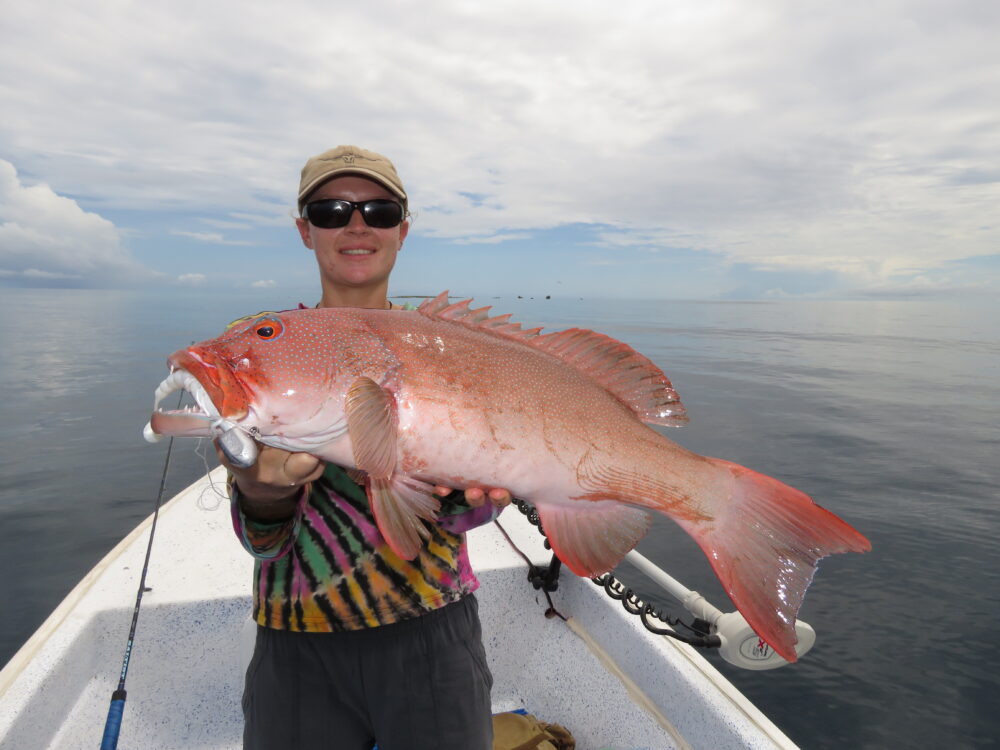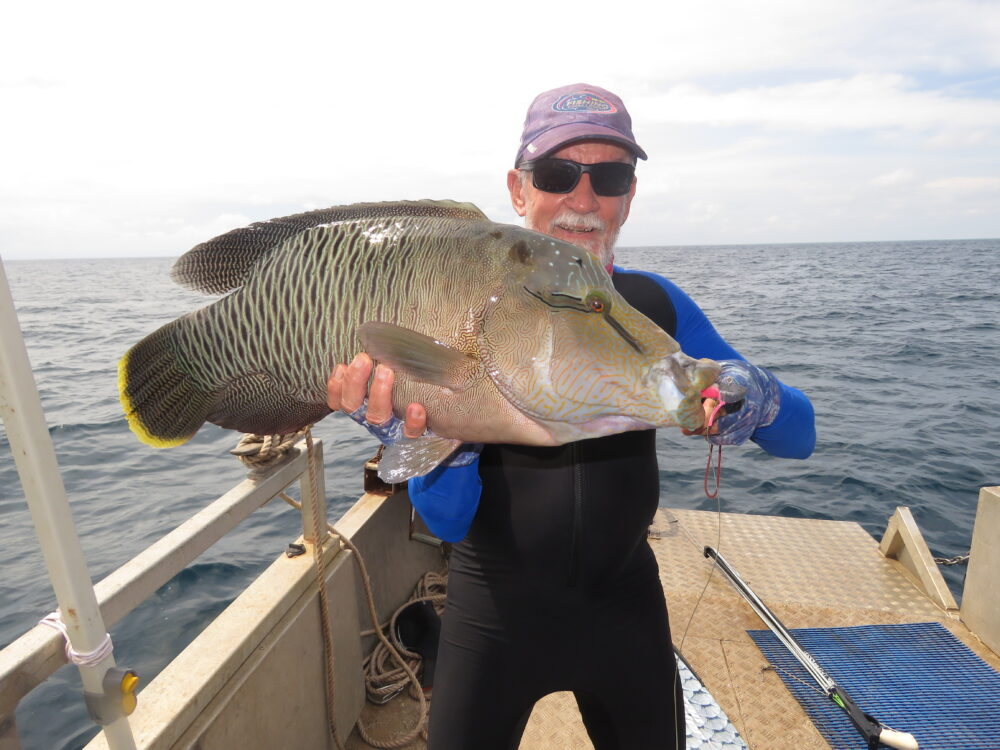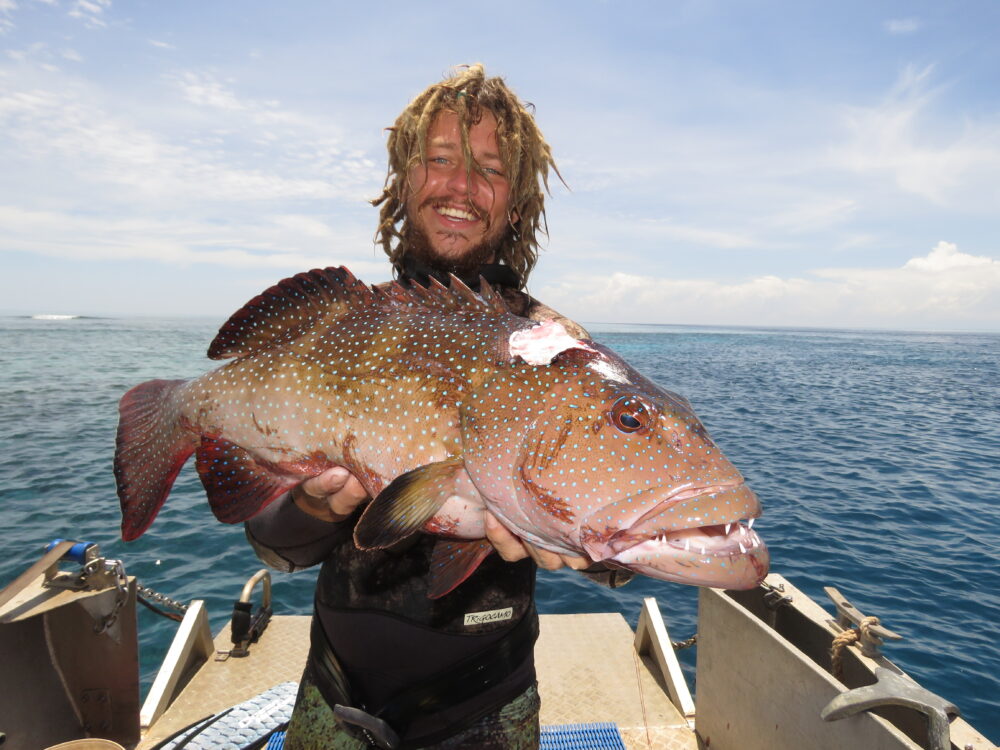Reef Plastics – By Dave Donald
To my mind, it was a natural progression – that may have been hastened after suffering badly bruised lower ribs courtesy of having a rod butt repeatedly slammed into my midriff while frantically jerking metal and lead head jigs back to the surface around reef areas and bait schools. Almost two decades ago, I decided to change pace and began experimenting with larger soft plastics offshore, a project that not only reduced the impact on my already tender appendages but proved to be readily acceptable to the predator population, as well.
Another major positive was the relative ease in which my charter clients were able to learn and adapt the techniques involved. Converting fishers who had only ever dropped baits on a reef to tying on a softie, proved easier than expected, even though most were very dubious of the productivity of such a relative unknown. While the numbers of bites may have been much less than those on a lump of squid, the size of fish landed on the rubbers was, on average, much larger when the hits actually happened. There were not many clients who failed to appreciate the satisfaction that came from boating quality over quantity!

Another trophy for the fish ‘whisperer’! Tilly managed to land this lovely Spaniard on a Berkley Gulp, its fangs avoiding the mono leader, while she steered the beauty away from a couple of hungry sharks.
Around this period of my guiding career, I was filming an episode of ‘Fish & 4 Wheels’ with long-time mate, Eddie Riddle, every year. I’m probably a little biased, but I’ve worked with quite a few shows over the years, and Eddie’s was definitely the standout. I was able to line up some amazing experiences and the fact that we bounced off each other well complimented the laid-back, yet informative, format that the series projected.
So the theme of the shoot that particular year, for what turned out to be Fish N 4’s final series, centred around highlighting the new soft plastic techniques that I’d been developing. Eddie, always the consummate professional, took to the technique like a duck to water, quickly matching the ‘guru’ in strike rate.
On one memorable day, we were drifting a bommie wide of Thud Point that was showing a bunch of large fish at the bottom of the drop-off on the up-current side.
First drop, my rod tip gave a couple of dips then slammed down hard when I set the hook, 50 pound braid crackling off the heavily set drag as the fish bolted. Ten seconds later, it was all over,
the cameraman barely having time to get the film rolling.
After re-rigging, we went back for another try. This time, both rods were crunched but my hook was the only one to find a jaw. I’d cranked the drag up a few more notches after that first wipe-out so was a little better prepared for the powerful run that followed. Still, it was definitely touch and go for a minute or so before, finally, I started to win. I still vividly remember Eddie and I yelling like maniacs when a 14kilo black jewfish appeared out of the depths and was guided into the waiting net. Meanwhile, the camera had recorded the entire encounter, possibly the first time a big black jew had been taken on a soft plastic.

Here’s Tilly again, this time with a plump coral trout taken on a Halco Paddle Prawn, one of the author’s favourite offshore plastics.
Fast forward to more recent times and a succession of trips to the largely untouched waters off Lockhart River and Portland Roads. These days, bait is rarely found in my boat.
If I can’t catch what I need on soft plastics, hard bodies and various jigs then I’ll take up knitting
– the upshot being my boat smells better and cleans easier! Hey, I’m a grumpy, fussy old man these days and don’t give a rats who knows it – and in any case it’s my boat, my rules!
There are a two different types of structure scenarios in these rich waters that require subtle variations in techniques to fish successfully, firstly the inshore habitats that include rocky islands, low coral or rubble and the enigmatic wonky holes. Then, there are the full blown coral reefs of the GBR where it’s easy to be overwhelmed by the massive abundance of seemingly endless likely spots.
But, as some philosophical caster once spruiked, ‘If it was easy, it would be called catching, not fishing!’ Fishing guides experience the nuances of this axiom more than most.
So, before we get into the nitty gritty, let’s first have a look at suitable tackle. As mentioned in my February ‘Battered & Crumbed’, the quality of spinning reels is so good these days that it’s hard to go past the medium to high end models for any offshore work these days. Daiwa, Shimano and Penn all have models up to the task, typically being able to hold 300 metres of 50 pound (22kg) braid while sporting an efficient bail roller, smooth drag and around 5 to 1 retrieve rate.
The most suitable rods should measure around 1.8m in length, be of high modulus graphite construction and medium progressive taper, rated for 50 pound(PE 5 to 7) use. The best ones are not cheap but pay off big time when that trophy fish comes along. My favourite is custom built on a Japanese Xzoga blank by Larry Lockwood, 1.75m long, on which I’m currently sporting a Shimano Saragosa SW10000.
Given the power of some of the species encountered and the abrasive nature of rocks and coral that mark their homes, a sturdy leader around 1.5 metres long is a necessity. Schneider make an excellent fluorocarbon material that tests around 40kg at 0.8mm diameter that ticks all of the boxes. Be sure to use a loop knot or heavy snap (Mustad Fastach size 4) to secure any jig heads – it’s important that the plastic is allowed to swim as naturally as possible.
As far as jigheads are concerned, it’s best to have a range of sizes from ¾ to 2oz built on heavy gauge hooks from 6/0 to 8/0. Both TT and Mustad have some excellent models. As this style of fishing entails the regular losses of jigs to snagging, smash ups or bite offs, carrying a minimum of 20 is recommended. Finding fish depends on keeping in constant touch with the bottom and that invariably means that snagging happens regularly.
The weight of the head used is dependant on prevailing current and drift, the stronger the run, the heavier the weight needed. Occasionally, even the heaviest example won’t reach bottom so there’s no option but to try and find a more sheltered spot to fish. Waiting for the tidal run to ease, by doing some trolling for example, is another possibility.
My favourite soft plastics come from the iconic Australian tackle company, Halco. Extensive testing of the Madeye Paddle Prawn and, more recent, Flick Stick models in the 7 and 5 inch sizes have produced a host of trophy sized coral trout, fingermark, cod, trevally, Spanish mackerel, red bass, nannaygai and those reef nasties, the Maori wrasse. Other top producers include Berkley Gulp Jerk Shads and Nemesis plus the Z Man jerk shad Z. While the big macs love a fast retrieved softie, their razor sharp fangs make short work of even the heaviest fluorocarbon – but occasionally the hook lodges in the right place!

Strikingly beautiful Maori wrasse love soft plastics almost as much as they like destroying tackle. Dave managed to wrangle this ‘smaller’ model but continually loses gear to its larger cousins.
When targeting a small area such as a coral bommie or wonky hole, the most productive routine is to anchor on the upwind or current side and drop the plastics into the strike zone. This is when a good electric motor fitted with spot lock makes things much easier. Plastics should be dropped straight to the bottom, rather than cast away from the boat, and the lure raised up a couple of turns on the reel when slack line signals that the reef has been reached. In a strong current, the jig will rise up and out of the productive area after a short time so line must be released from the spool until bottom is once again reached – and that process continued for four or five hops. Then it’s best to retrieve the lure and start again.
The larger reef areas require a more focussed approach. Most outer GBR structures drop from a few metres depth to 30 or so in as little as 20 metres from their edge. Identifying pressure points, detached bommies or more gently sloping ledges are the key to finding fish regularly. My experience so far has identified that water depths from 25 to 30 metres seem to be more productive. The down side is that staying in this very narrow strip often requires a high degree of boat manoeuvring.
While metal and lead head jigs require a high degree of effort in the jigging process, soft plastics, by their very nature, are best fished with a minimum of jerking or speed. I’ve often had softies grabbed while not retrieving at all, even with the rod placed in a holder. A slow lift from the water surface to navel level is sufficient movement. Lifting the rod high reduces your ability to strike properly if there’s a strike at the uppermost point.
Once a bump is felt, resist the urge to strike, instead lowering the tip of the rod slightly to allow the line to come tight. If weight is felt, lift the rod to set the hook then pump and wind as fast as possible to get the fish away from the bottom. This is the most critical time as big fish will suddenly realize they are hooked and all hell will break loose.
Big Maori wrasse are the worst! They can pull 10 or 15 metres from even the tightest drag and find the coral. I was annihilated three times on one particular bommie between opposing reef edges recently. The fourth and final try produced a 7kg wrasse!
The secret to mastering any new technique is perseverance. It’s no good going in half-baked and unprepared. Putting a couple of keepers in your icebox quickly justifies any hard work expended. It all becomes much easier after the first few times!
Tight lines!







